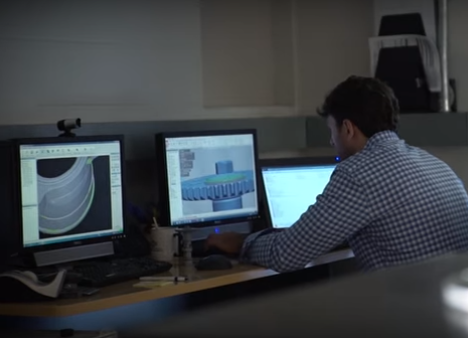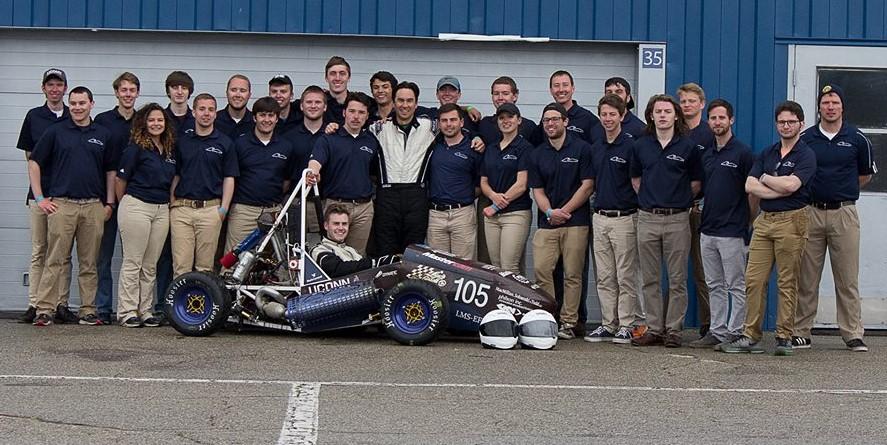
[Image: UConn Formula SAE via Facebook]
The first Formula SAE competition took place in 1979; since then, it has grown and expanded into a multinational organization with races all over the globe. The University of Connecticut has been participating since 2009 with teams formed of students from the Department of Engineering. When they began planning their design for this year’s competition, the students decided that they could design their vehicle more effectively and efficiently if they had a 3D CAD model of their engine.
 For help, the team reached out to Bolton Works, an East Hartford, Connecticut company specializing in 3D scanning, metrology and reverse engineering, and asked if they could scan and create a detailed 3D model of the engine. Bolton Works agreed to help, and began researching by examining other engines that had been 3D scanned and modeled. They were less than impressed.
For help, the team reached out to Bolton Works, an East Hartford, Connecticut company specializing in 3D scanning, metrology and reverse engineering, and asked if they could scan and create a detailed 3D model of the engine. Bolton Works agreed to help, and began researching by examining other engines that had been 3D scanned and modeled. They were less than impressed.
“We looked into what other universities did so far,” said Mark Bliek, President of Bolton Engineering. “What we noticed is that either the models were not very detailed, or they were built in a way that the individual components could not be taken off the model.”
 The company wanted to do better than that, so they started by scanning the entire assembled engine and converting the data into an STL file. They then took the engine apart and scanned each individual component, importing the scan data with 3D Systems’ Geomagic Wrap software. Using the scan of the assembled engine as a template, they reassembled the individual components into a new model with Geomagic Design X software. The finalized CAD parts were then transferred into SOLIDWORKS MCAD software.
The company wanted to do better than that, so they started by scanning the entire assembled engine and converting the data into an STL file. They then took the engine apart and scanned each individual component, importing the scan data with 3D Systems’ Geomagic Wrap software. Using the scan of the assembled engine as a template, they reassembled the individual components into a new model with Geomagic Design X software. The finalized CAD parts were then transferred into SOLIDWORKS MCAD software.
“Before we only had this kind of vague model that only had a few reference points off of the engine…but nothing really accurate,” said UConn Formula SAE’s Chief Engineer Jon Sobanski. “So when we got this new model, we were finally able to create a much more intricate intake mount that interfaced with the engine. Not only that, but we were able to actually design our frame around the engine for the first real time.”
According to Bliek, a project like this one would have taken at least six months with older software programs. With 3D Systems’ software, he said, it took the company only a month from start to finish.
“The CAD data that Bolton Works has provided us has enabled us to get all of our parts to fit together exactly how they need to, so the differential is spaced perfectly, and the intake fits perfectly,” said Mikaela Worthington, the team’s Powertrain Engineer. “None of that would have been possible if we were trying to model it all by hand.”
The multiple-race SAE competition took place in Michigan from May 11-14. Despite some weather-related setbacks, the UConn team came in 26th out of 100 teams, and were very pleased with the car’s performance. You can learn more below and from 3D Systems. Discuss this project further in the 3D Model Helps Create Racecar forum over at 3DPB.com.
Subscribe to Our Email Newsletter
Stay up-to-date on all the latest news from the 3D printing industry and receive information and offers from third party vendors.
You May Also Like
3D Printing News Briefs, April 13, 2024: Robotics, Orthotics, & Hypersonics
In 3D Printing News Briefs today, we’re focusing first on robotics, as Carnegie Mellon University’s new Robotics Innovation Center will house several community outreach programs, and Ugogo3D is now working...
Rail Giant Alstom Saves $15M with 3D Printing Automation Software 3D Spark
3D Spark has entered into a three-year deal with the rail giant Alstom. Alstom, a transport behemoth with annual revenues of $16 billion, specializes in the manufacture of trains, trams,...
Meltio Expands Global Reach with New Partnerships in the Americas and Europe
Spanish 3D printing manufacturer Meltio has expanded its sales network across the globe. With the addition of three new partners in the United States, Brazil, Argentina, and Italy, Meltio aims...
3D Printing Webinar and Event Roundup: April 7, 2024
Webinars and events in the 3D printing industry are picking back up this week! Sea-Air-Space is coming to Maryland, and SAE International is sponsoring a 3D Systems webinar about 3D...
































